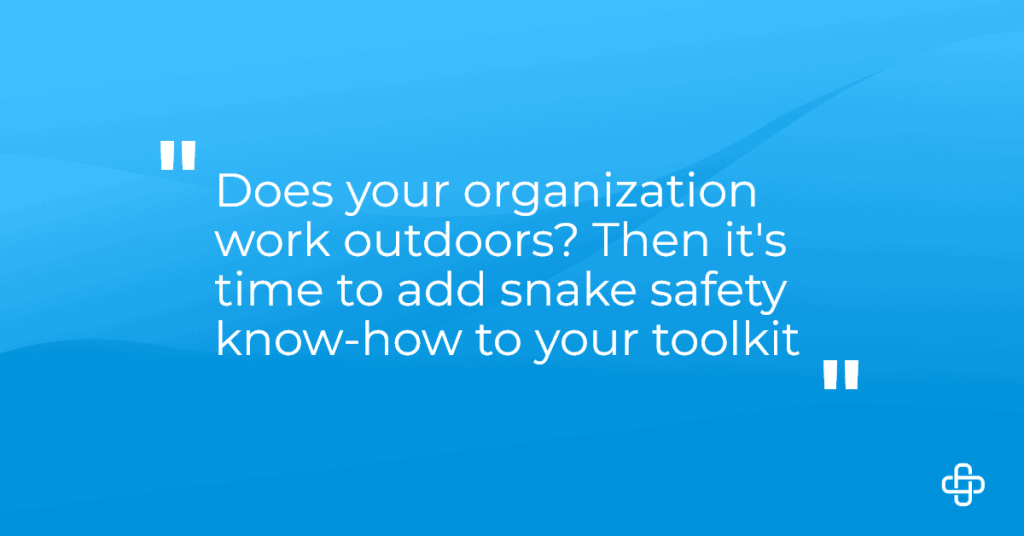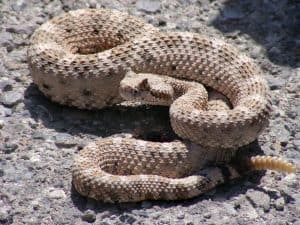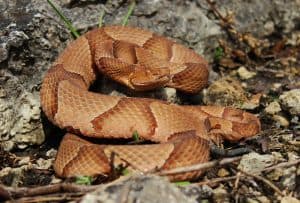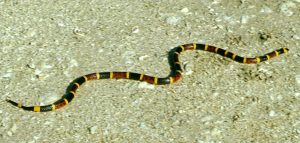Does your organization work outdoors? Then it’s time to add snake safety know-how to your toolkit.
Snake bites are one of the oldest workplace dangers. So old that our brains are pre-programed to fear snake-like patterns from birth. If only we were naturally wired to avoid other workplace hazards too!

But while we may instinctively fear snakes, that doesn’t mean we automatically know how to handle them. Let’s tackle some common questions about staying safe around snakes.
Q: How likely am I to get bitten by a snake?
A: Around 8,000 snake bites occur annually in the U.S., across all lower 48 states. Of these bites, 13.9% happen at work, and 56% occur outdoors. While fatalities are rare, venomous bites can lead to serious complications like kidney failure and blood clotting.
Q: What are the most common venomous snakes in the U.S. and where are they found?
A: The U.S. has four main types of venomous snakes: rattlesnakes, copperheads, cottonmouths, and coral snakes. As climate change and loss of wilderness continues to affect their habitats, these snakes are moving farther north and into areas where more people live.
- Rattlesnakes: If you hear that tell-tale rattle, freeze and look around your feet. Look for a diamond pattern, tan or olive-green coloring, and a broad, triangular head. Rattlesnakes are most common in the Southwest and Southeast, with Western Diamondbacks and Timber Rattlesnakes being the most widespread species.

- Copperheads: These venomous snakes are a good reason to stick to the beaten path, as their coppery-tan bodies blend perfectly into leaf litter. They are most common in the eastern and central U.S., especially in wooded areas, near water, and even in some suburban spots. If copperheads feel threatened, they will hiss, vibrate their tail, and maybe even strike.

- Cottonmouths: Also known as Water Moccasins, these snakes are commonly found near water sources in the Southeast, such as swamps, rivers, and lakes. They are often mistaken for non-venomous snakes (for obvious reasons, it’s best to avoid this mistake). Cottonmouths can be distinguished from similar non-venomous snakes by their thick, muscular bodies, vertical pupils, and their habit of floating on water rather than swimming submerged. The name ‘Cottonmouth’ comes from the white interior of their mouths, which they display when feeling threatened or defensive.

- Coral Snakes: Although their venom is highly potent, coral snake bites are rare due to their shy and reclusive nature. These snakes are primarily found in the Southwest and Southeast. The famous rhyme, ‘Red against yellow, deadly fellow; red against black, friendly Jack,’ helps identify coral snakes by their red, yellow/white, and black banding. However, not all coral snakes have this banding, and not all snakes with similar banding are coral snakes. Still, it’s a handy phrase in a pinch.

Q: How do I make our worksite less attractive to snakes?
A: A piecemeal approach can significantly reduce the likelihood of encounters with venomous snakes.
- If you Sweep up, They’ll Slither Away
Snakes seek shelter in hidden, cozy spots. Are there areas of overgrown vegetation or piles of rocks, scrap wood, or other debris on your worksite? These are essentially invitations for snakes to settle in. Decluttering these areas significantly reduces the chances of snake activity. Maintain a clear perimeter around the worksite by trimming grass, weeds, and bushes. Short, well-maintained vegetation makes it harder for snakes to hide and discourages them from lingering. Bonus tip: Certain plants, like marigolds and lemongrass, are believed to repel snakes when planted strategically around the site.
- No Free Lunch
Did you know proper waste management doubles as snake deterrent? While these reptiles don’t scavenge for scraps or garbage themselves, their prey—like rodents, insects, and other small animals—certainly do. So don’t unintentionally create a buffet for snakes at your worksite. To halt this domino effect, ensure all waste is disposed of promptly and securely. Use trash bins with tight-fitting lids to prevent access and regularly clean the area around waste disposal sites to eliminate lingering food odors. Consider setting up designated waste zones away from high-traffic areas and inspecting them frequently for signs of pests. By cutting off this food supply, you can significantly reduce the chances of snakes slithering in for a bite.
- Standing Water = Standing Invitation for Snakes
Snakes are naturally drawn to water sources, as they provide a moist, cool environment perfect for breeding and attracting thirsty prey. To minimize this risk, promptly fix any leaks and ensure proper drainage around the worksite to prevent standing water. If the site relies on water features for operations, limit access to these areas and maintain them regularly. Perform regular inspections to keep water sources under control. Also check for newly formed puddles after rain, clogged drains, or any unnoticed leaks that could foster a snake-friendly environment. Intercepting potential issues early ensures that your worksite doesn’t become a watering hole for uninvited guests.
- Serpent Security
Securing the area can help everyone feel safer. If your team works in places with a lot of snakes, like in the Southwest or Southeast, putting up snake-proof fences might be a good idea. These fences should have very small gaps, no bigger than 1/4 inch, and the bottom should go underground to keep snakes from digging under. For buildings, make sure to seal gaps or cracks with materials like caulk, steel mesh, or weatherstripping to keep snakes out. It’s also important to keep workers protected. Make sure everyone is wearing long pants and strong boots. This kind of protective gear can help prevent injuries if someone accidentally steps on a snake or gets too close to one.
- Address the Elephant Reptile in the Room
Prevention starts with awareness. Train your team to recognize signs of snake activity, such as:
– Shed Skin: Snakes shed their skin as they grow, so finding a snake’s shed skin is a clear sign one has been nearby.
– Tracks or Trails: In dusty or sandy areas, you might notice slithering tracks or trails left by a snake’s movement.
– Droppings: Snake droppings are often dark and may contain fur, bones, or other remnants of their prey.
– Unusual Sounds: Hissing or rustling noises in bushes, under equipment, or in storage areas could indicate a snake.
– Burrows or Holes: Some snakes use abandoned burrows or holes for shelter. If you notice new or unusual holes, it could be a sign.
– Sightings of Prey Animals: An increase in rodents, frogs, or other small animals greatly increases the risk of snakes in the area.
– Warm, Sheltered Areas: Snakes are drawn to warm, hidden spots like under machinery, in piles of debris, or near heat sources.
Furthermore, encourage your team to take note of a snake’s markings if they spot one.
Q: What should I do if I’m bitten by a venomous snake?
A: Here’s the scenario: it’s the end of a long day of hard work, and the job site is bathed in the glow of the setting sun. You bend down to clear a pile of cut grass and your hand inadvertently touches something cold and smooth. You jump back.
Suddenly, you’re looking back and forth between two dripping fangs and two identical incision marks on your hand. It’s a cottonmouth snake and you’ve been bitten! Your heart races and you feel dizzy. Luckily, your co-workers help you to S.T.A.Y. C.A.L.M.
S.T.A.Y.
- Stay still: Keep the victim as still as possible to slow the spread of venom.
- Tell someone: Call for emergency help immediately (911 or local emergency services).
- Avoid panic: Reassure the victim and keep them calm.
- Yield movement: Immobilize the affected limb and keep it below heart level.
C.A.L.M.
- Clean the wound: Gently clean around the bite with water, but don’t wash or suck the venom out.
- Avoid tourniquets: Do not apply a tourniquet or cut the wound.
- Loosen clothing: Remove tight clothing or jewelry near the bite area in case of swelling.
- Monitor: Keep an eye on the victim’s breathing, pulse, and symptoms while waiting for help.
Q: How can I learn more about snakes and other venomous wildlife?
A: If you’d like to learn more about avoiding dangerous animal encounters, it’s best to talk to the experts. Watch our recent webinar, Venomous Threats: Safeguarding Against Springtime Bites with Chief Medical Officer, Dr. Scott Cherry, and Emily Roberts, owner of Snake Discovery, where we’ll equip you with essential tools for identifying dangerous species, responding to bites, and enhancing outdoor safety. Don’t miss this opportunity to keep your team safe this season!

Cain Boney is a contributor to Axiom Medical’s blog. With a career dedicated to writing about the workplace, Cain focuses on how employee well-being affects organizational success and sustainability in the long term.










